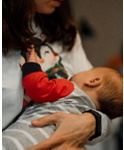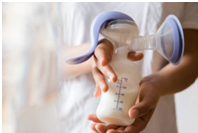Dr Sathya – #1 Approved Lactation Consultant in Chennai (NHCA Singapore)
Lactation Consultant in Chennai
Call Us
+91 7200148548
Email Us
cutikidz2022@gmail.com
Book Your Lactation Counselling
The Science Behind Lactation
We have often heard the saying “It takes a village to raise a child” which is so true in current scenario. With the advent of modernization and nuclear family concept, we are moving far away from our roots that even a very normal, old traditional practice of breastfeeding has become an important and untold topic for the millennial moms. So don’t worry. You are not alone.
Many new moms are worried about breastfeeding.The experience which other mothers share about breastfeeding like sleepless nights,the fear of pain during breastfeeding,lack of milk or reduced milk supply all, insisting to introduce formula milk by family members, elders,peer pressure, postpartum blues all these seems to be overwhelming for an expectant mother/ new mom.


Breastfeeding is nature’s gift to nurture the next generation.Over decades the very old and natural process of breastfeeding newborn has lost importance due to various other reasons. And now millennial moms have understood the reality and importance of breastfeeding and the normalcy is returning.
Women has tremendous ability to handle any challenges in life, one such being childbirth and breastfeeding. Trust me breastfeeding is a more pleasant, enjoyable, and relaxing journey for both the mother-baby dyad which they shall cherish for lifetime.
Every woman has got inherent capacity to breastfeed their little ones, irrespective of their social,emotional, educational, and economical background. So, trust your body, bepositive, relish your breastfeeding journey and seek help when needed.
Lactating Positions for Your Child


Establishing comfortable and effective breastfeeding positions is crucial for both the mother and the baby. Here are some common lactation positions that you can try with your child:
Cradle Hold:
- Sit in a comfortable chair or use pillows for support.
- Cradle your baby’s head in the crook of your arm on the same side as the breast you’re nursing from.
- Support your baby’s back with your forearm and use your free hand to support your breast if needed.
- Ensure your baby’s body is facing yours, with their mouth aligned with your nipple.
Football Hold (Underarm or Clutch Hold):
- Sit in a chair or on a couch with pillows for support.
- Position your baby at your side, with their body tucked under your arm and their legs and feet behind you.
- Support your baby’s head with your hand and their body with your forearm.
- Use a pillow to support your arm if needed.
Side-Lying Position:
- Lie on your side in bed with pillows behind your back and under your head for support.
- Place your baby on their side facing you, with their mouth at breast level.
- Use your lower arm to support your baby’s head and guide them to latch onto your breast.
- You can use your upper arm to cradle your baby or support your breast if needed.
Reclined Position:
- Sit back in a recliner or on a bed with pillows for support.
- Lay your baby across your chest, with their body facing yours and their mouth aligned with your nipple.
- Use your hands to support your baby’s head and guide them to latch onto your breast.
- This position can be helpful for babies who have difficulty latching or for mothers who have engorged breasts.
Cross-Cradle Hold:
- Sit in a comfortable chair with pillows for support.
- Cradle your baby’s head in the crook of the opposite arm from the breast you’re nursing from.
- Support your baby’s back with your free hand and use your other hand to guide your breast and support your baby’s head.
- This position can provide more control for latching, especially for newborns or babies who have difficulty staying latched.
Laid-Back or Biological Nursing Position:
- Lie back in a semi-reclined position, with pillows for support under your head and shoulders.
- Place your baby on top of you, with their body facing yours and their head near your breast.
- Allow your baby to self-attach by using their instincts to find and latch onto your breast.
- This position can promote relaxation for both the mother and baby and can encourage deeper latching and more effective milk transfer.
Experimenting with different breastfeeding positions can help you find what works best for you and your baby. It’s essential to ensure that both you and your baby are comfortable and that your baby has a good latch for effective milk transfer. If you’re experiencing difficulties with breastfeeding or finding the right position, don’t hesitate to seek support from a lactation consultant or healthcare provider. They can offer guidance and assistance to help you and your baby achieve successful breastfeeding.

Treatments for Sore Nipple and Nipple Pain
- Correcting the latching technique
- Warm compresses
- Starting with the less affected side first while feeding
- Applying breast milk over the affected area after feeding
- Comfortable fit inner wear usage (not too tight or loose)
- All-purpose nipple ointment after consulting your pediatrician/ lactation specialist
Managing Low Milk Supply
While encountering low milk supply can be challenging, several strategies can help improve milk production and support breastfeeding success:
- Nurse Frequently: Breastfeed your baby on demand, aiming for at least 8 to 12 feedings per day to stimulate milk production effectively.
- Ensure Proper Latch and Positioning: Work with a lactation consultant to ensure your baby is latching correctly and breastfeeding in a comfortable position.
- Practice Skin-to-Skin Contact: Holding your baby skin-to-skin can enhance bonding and stimulate milk production.
- Stay Hydrated and Well-Nourished: Drink plenty of fluids and consume a balanced diet rich in nutrients to support milk production.
- Manage Stress: Engage in relaxation techniques, such as deep breathing, meditation, or gentle exercise, to reduce stress levels and promote milk production.
- Consider Galactagogues: Some herbs, foods, and medications, known as galactagogues, may help boost milk supply. Discuss their use with a healthcare provider.

Treatments for Nipple Injury
Nipple injury treatment involves several steps to alleviate discomfort and promote healing:
Ensure Proper Latch: A correct latch helps prevent further irritation. Ensure your baby’s mouth covers a large portion of the areola with lips flanged outwards.
Keep Nipples Dry: Moisture can worsen injuries. Pat nipples dry gently after feeding and avoid harsh soaps or alcohol-based products.
Apply Breast Milk or Nipple Cream: Breast milk has healing properties. Apply a small amount after feeding. Nipple creams can also soothe soreness.
Use Warm or Cold Compresses: Warm compresses before feeding soothe soreness and encourage milk flow. Cold compresses afterward numb the area and reduce swelling.
Experiment with Breastfeeding Positions: Different positions can alleviate pressure on sore nipples. Try side-lying, football hold, or reclined nursing to find what’s comfortable.
Rest and Relax: Adequate rest and relaxation promote healing and reduce stress, which can worsen pain.
Seek Medical Attention: If injuries don’t improve or show signs of infection like redness or discharge, consult a healthcare provider for appropriate treatment, such as antibiotics or specialized wound care.
Causes & Solutions For Mastitis
Mastitis is a painful inflammation of breast tissue, often caused by a bacterial infection. It typically affects breastfeeding women, although it can occur in non-breastfeeding individuals as well. Here’s a brief overview:
Symptoms: Mastitis symptoms may include:
- Breast tenderness or pain, often localized to one area
- Swelling or redness of the breast
- Warmth or heat in the affected area
- Fever or chills
- Flu-like symptoms such as fatigue or body aches
- Hard lump or area of engorgement in the breast
Causes: Mastitis often occurs when milk ducts become blocked, leading to milk stasis and bacterial growth. Factors that can contribute to mastitis include:
- Inadequate breastfeeding or pumping, leading to engorgement
- Poor latch or ineffective milk removal
- Cracked or damaged nipples, providing entry points for bacteria
- Weakened immune system
- Stress or fatigue
Treatment: Treatment for mastitis typically involves a combination of self-care measures and medical interventions:
- Continue Breastfeeding: Continuing to breastfeed helps drain the breast and clear the infection. It’s safe for both mother and baby.
- Rest and Hydration: Rest and staying hydrated can help support the immune system and aid in recovery.
- Pain Relief: Over-the-counter pain relievers such as ibuprofen can help alleviate discomfort and reduce inflammation.
- Warm Compresses: Applying warm compresses to the affected breast can help relieve pain and encourage milk flow.
- Antibiotics: If mastitis is caused by a bacterial infection, antibiotics may be necessary. Always consult a healthcare provider for proper diagnosis and treatment.
- Frequent Nursing or Pumping: Ensuring frequent and effective milk removal helps prevent further blockages and promotes healing.
- Address Underlying Issues: Addressing any underlying issues such as poor latch or ineffective breastfeeding techniques can help prevent recurrence.
Prevention: To help prevent mastitis, it’s important to:
- Ensure proper breastfeeding technique and latch.
- Avoid skipping feedings or going too long between feedings.
- Maintain good breast hygiene, including keeping nipples clean and dry.
- Address any breastfeeding difficulties promptly.
- Practice good self-care, including getting enough rest and managing stress.
Oral dysfunction in babies
Oral dysfunction in babies refers to difficulties or abnormalities in the oral structures or functions that can affect feeding, swallowing, speech development, and overall oral health. Here’s an overview
Causes: Oral dysfunction in babies can have various causes, including:
- Structural abnormalities such as tongue-tie (ankyloglossia) or cleft lip/palate.
- Neurological conditions affecting oral motor control.
- Premature birth or low birth weight, which can affect oral development.
- Muscular weakness or tone issues.
- Respiratory problems impacting sucking and swallowing coordination.
- Genetic factors or syndromes affecting oral structures
Treatment and Management: Treatment for oral dysfunction in babies depends on the underlying cause and may involve:
- Lactation support and guidance for breastfeeding mothers, including techniques to improve latch and positioning.
- Oral exercises and stimulation to improve oral motor function.
- Surgical intervention for structural abnormalities like tongue-tie or cleft lip/palate.
- Feeding therapy or interventions to address feeding difficulties and promote proper nutrition.
- Speech therapy to support speech and language development as the child grows older.
- Collaborative care involving a multidisciplinary team of healthcare professionals to address the baby’s comprehensive needs.

Latching Techniques
Positioning: Sit comfortably with back support, hold baby close with their nose in line with your nipple, and ensure their head and body are aligned.
Supportive Hold: Use cradle or football hold to support baby’s head and body while nursing.
Breast and Nipple Positioning: Hold breast with thumb on top and fingers underneath in a “C” shape. Stroke baby’s lower lip to encourage wide mouth opening.
Achieving a Deep Latch: Ensure baby’s mouth covers a large portion of the areola with lips flanged outwards, aiming nipple towards roof of mouth.
Nursing Frequency: Nurse frequently (8-12 times/day) to encourage milk production and prevent engorgement.
Comfort and Relaxation: Relax shoulders and back, take deep breaths, and seek help from a lactation consultant or healthcare provider if experiencing pain or difficulty.
Antenatal counselling
Positioning: Sit comfortably with back support, hold baby close with their nose in line with your nipple, and ensure their head and body are aligned.
Supportive Hold: Use cradle or football hold to support baby’s head and body while nursing.
Breast and Nipple Positioning: Hold breast with thumb on top and fingers underneath in a “C” shape. Stroke baby’s lower lip to encourage wide mouth opening.
Achieving a Deep Latch: Ensure baby’s mouth covers a large portion of the areola with lips flanged outwards, aiming nipple towards roof of mouth.
Nursing Frequency: Nurse frequently (8-12 times/day) to encourage milk production and prevent engorgement.
Comfort and Relaxation: Relax shoulders and back, take deep breaths, and seek help from a lactation consultant or healthcare provider if experiencing pain or difficulty.

Postpartum blues
Breast pumps are tools used by nursing mothers to express and store breast milk. Here’s a brief overview of their use:
Purpose: Allows mothers to express milk for various reasons, including returning to work, relieving engorgement, increasing milk supply, or feeding the baby via a bottle.
Types: Manual and electric pumps are available. Manual pumps require hand-operated pumping, while electric pumps use a motor for automatic suction.
How to Use: Position the breast shield over the nipple, start the pumping process, and continue until milk flow slows down. Store expressed milk in labeled containers or breast milk storage bags.
Maintaining Hygiene: Clean and sanitize pump parts after each use following manufacturer’s instructions to prevent contamination.
Storage and Handling: Expressed milk can be stored safely in the refrigerator or freezer. Follow breast milk storage guidelines and label containers with date and time of expression.
Safety Considerations: Follow safe handling practices and discard milk left at room temperature for more than 2 hours.
Seeking Support: Consult a lactation consultant or healthcare provider for guidance and troubleshooting if needed.
Weaning to solids is the gradual introduction of solid foods to a baby’s diet, typically starting around 6 months of age. Here’s a brief guide:
- Begin with single-ingredient, pureed or mashed foods.
- Introduce common allergenic foods one at a time.
- Progress to textured foods as your baby becomes accustomed.
- Start with one meal a day and gradually increase.
- Follow your baby’s cues for hunger and fullness.
- Offer a variety of nutrient-rich foods.
- Avoid added sugar, salt, and choking hazards.
- Transition gradually from breast milk or formula.
- Consult a healthcare provider for guidance and support as needed.
Weaning to solids

Extended breastfeeding Benefits
Extended breastfeeding, which refers to breastfeeding beyond infancy and into toddlerhood or beyond, offers various benefits for both the child and the mother:
Nutritional Benefits: Breast milk continues to provide essential nutrients, vitamins, and antibodies that support the child’s growth and development, even as they transition to solid foods.
Immune Support: Breast milk contains antibodies and immune factors that help protect the child from infections and illnesses, reducing the risk of respiratory infections, gastrointestinal infections, and other common childhood illnesses.
Emotional Bonding: Extended breastfeeding promotes a strong emotional bond between the child and the mother, fostering feelings of security, comfort, and closeness.
Brain Development: Breastfeeding has been associated with cognitive benefits, including enhanced brain development and improved cognitive function in children.
Physical Health: Extended breastfeeding may offer long-term health benefits for the child, such as reduced risk of obesity, diabetes, asthma, and allergies.
Psychological Well-being: Breastfeeding provides emotional support and reassurance for the child, promoting a sense of well-being and security.
Convenience: Breastfeeding is convenient and readily available, providing quick nourishment and comfort for the child, especially during times of illness or distress.
Cost-effectiveness: Breastfeeding is cost-effective compared to formula feeding, saving money on formula costs and healthcare expenses associated with childhood illnesses.
Health Benefits for the Mother: Extended breastfeeding has been associated with reduced risk of certain cancers, including breast and ovarian cancer, and may also support maternal mental health by reducing the risk of postpartum depression.
Environmental Impact: Breastfeeding is environmentally friendly, as it produces no waste or packaging and requires fewer resources than formula feeding.
Overall, extended breastfeeding offers a range of physical, emotional, and psychological benefits for both the child and the mother, supporting optimal health and well-being throughout early childhood and beyond.
Here I am Dr.Sathya MBBS,MD Lactation Specialist (NHCA Singapore). I will share few of the common doubts which mothers ask me in my day to day practice. I have compiled all the needed information, which is easily understandable for everyone.
Frequently Asked Questions
Immediately after birth, as early as possible
It is easy to make the baby latch during the first hour of birth (golden period) as the baby will be active at that time and it is easy to latch the baby to the breast. After that the baby will go in for a deep sleep phase.
What is skin to skin contact and what are the advantages of it?
It is essential to provide skin to skin contact for baby and the mother immediate postpartum and it has lots of benefits
- Helps initiate breastfeeding
- Stimulate oxytocin release by the mother
- Helps in milk ejection
- Contracts uterus and reduce bleeding
- Facilitate mother baby bonding
- Regulates baby’s body temperature
- Baby feels loved and enjoy mothers’ warmth

This is the common complaint which I receive from almost 40-50% of the mothers, in fact this could be the major reason for stopping breastfeeding. When we further investigate those mothers, about 80-90% of them have issue with latching and once the proper positioning and attachment is taught to them, then breastfeeding continues without any further difficulties. The problem is many mothers don’t seek proper help at the right time before deciding to quit breastfeeding.
- Baby should be turned towards the mother
- Baby’s chin should touch the mother’s breast
- Lower lip should be everted
- Upper part of the areola should be visible more than the lower part.
- If all these factors are done properly, then breastfeeding shouldn’t be painful for you.
Here again the major culprit would be latching issue. There are various reasons for nipple pain.
- Sore nipple due to improper latch
- Candid infection of nipple
- Atopic dermatitis
- Eczema of the nipple
- Tongue tie for the baby
- Mastitis / infection of breast
- Raynaud’s phenomenon
- Mammary constriction syndrome
- Milk blisters/blebs
- Blocked milk duct
Tongue tie is a small tissue which connects the tongue to the floor of the mouth, thereby restricting the movement and hence difficulty in latching, cracked nipples, sore nipples, more biting and the cycle continues. Check with your pediatrician/ lactation specialist and if tongue tie is identified a small surgical procedure is required to release it. After surgery you could see the baby wonderfully latching at the breast and the story begins.

Many mothers have an apparent feel that they have less milk supply, and they are not able to meet the needs of the baby. Milk supply is based on the demand supply cycle and various other factors. Adequate hydration, proper balanced diet, more of skin to skin contact with baby, positive thinking will have an impact on breast milk production. In simple words, the more you breastfeed, the more the baby sucks, the more milk you produce.
Feeling confident about your milk supply is one of the major factors in boosting your milk supply (I have seen drastic improvement in most of my patients).
And a baby crying continuously after feeding is not an indication to start formula feed.
Weight gain is not the only parameter to decide on the adequacy of breastfeeding. If the baby is feeding well at breast and passing urine 6-8times/day, active and achieving all the developmental milestones well and the weight gain is falling within the expected normal range ,you need not doubt your breastmilk supply. Slow and steady weight gain is acceptable if the baby is content and otherwise normal.
If you have breast engorgement in the initial days, it is probably due to fluid accumulation in the breast tissue rather than over supply of milk.so hand express some amount of milk just before latching so that you don’t get pain during feeding.
Cold compresses, breast compression after feeding,NSAIDs,latching as much as possible will help.
Reverse pressure softening after discussing with your lactation specialist will be of immense help.
Nipple shield has become a fancy tool to regulate and support breastfeeding and it is believed to be the one stop solution for all breastfeeding problems. But that is not true. There are many assumptions that if a baby is not sucking properly or if the mother has flat nipple, nipple shield is the only solution available.In fact, nipple shield will worsen the pain during breast feeding or more likely the mother will resort to pumping and giving her milk by bottle rather than latching directly.
There are various conditions where nipple shield is absolutely indicated and should be used under proper guidance of a lactation specialist. When the baby sucks on a nipple shield then more likely the milk supply will decrease eventually thus complicating the situation.

Not really. You can very well breastfeed by just sitting on a chair, with a pillow for back support, one firm pillow on the lap to hold the baby, a small foot rest, to keep your foot comfortably so that there is no pressure on the back.
Feeding pillow can be used in special situation like feeding twins, prenataltrauma, mother with sciatica or if you are comfortable using it. But definitely you can feed without a proper feeding pillow.
My baby often cries in the evening and night even after feeding her. Is this due to colic pain? What is the solution?
Most common complaint which I see in my day-to-day practice is a newborn baby 1 to 3months of age crying continuously at night. Yes the common reason is colic pain.
By definition, colic is defined as an incessant cry which starts at about three weeks of age, cries for about 3hours/day, at least 3 days/week last until baby is about 3months of age. Typically the cry occurs in the late evening.
Best methos to overcome the colic is holding the baby, carrying the baby, skin to skin contact, carry ,walk and talk. Mother’s voice is the best medicine. Talk or sing and rock and assure the baby that he is not alone. Infant massage can also help.

World health organization says exclusive breastfeeding till 6 months of age and continue breastfeeding along with complementary feeding till 2years of age and beyond. The decision to stop breastfeeding depend on the mother and baby. I have seen mother’s who had breastfed till 5 years of age. so there is no upper limit for breastfeeding. Natural weaning occurs eventually. Trust me you and your baby will cherish this breastfeeding journey forever.

Many a times, breastfeeding mother is so much indulged in taking care of the newborn baby that, she is less concerned about her sexual relationship. It is always hard for the new father to feel dejected, struggling to understand the physical and emotional changes of her partner and this topic is not opened up at all.
Scientifically reduced libido/sexual desire is common and normal for a breastfeeding mom and her interest will gradually increase over a period of time. Father should accept the new normal and provide emotional support to the mother. After all she is raising his own child. If the father understands that the love and care for the baby is more important for development of the baby, he will encourage rather than try to interrupt it. Discuss as a couple with your lactation specialist and get proper guidance and support rather than heating up the relationship.

Yes. You can very well pump your breast milk and feed your baby in your absence. You and caretaker should be properly educated about the pumping and storage of breast milk and proper thawing process. Get an in person consult from you pediatrician/lactation consultant and continue the giving your breast milk even in your absence, nothing is impossible.

